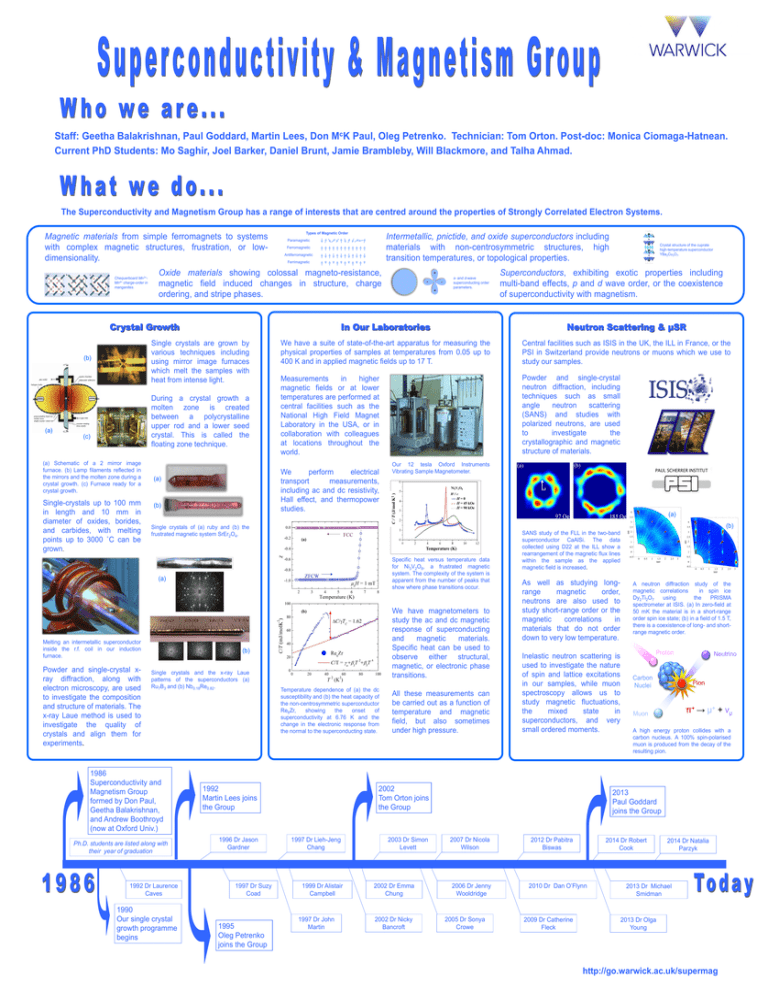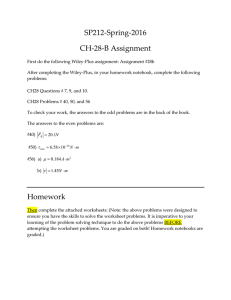Magnetic Intermetallic, pnictide, and oxide superconductors
advertisement

Staff: Geetha Balakrishnan, Paul Goddard, Martin Lees, Don McK Paul, Oleg Petrenko. Technician: Tom Orton. Post-doc: Monica Ciomaga-Hatnean. Current PhD Students: Mo Saghir, Joel Barker, Daniel Brunt, Jamie Brambleby, Will Blackmore, and Talha Ahmad. The Superconductivity and Magnetism Group has a range of interests that are centred around the properties of Strongly Correlated Electron Systems. Antiferromagnetic Ferrimagnetic Oxide materials showing colossal magneto-resistance, magnetic field induced changes in structure, charge ordering, and stripe phases. Crystal Growth Single crystals are grown by various techniques including using mirror image furnaces which melt the samples with heat from intense light. (b) quartz chamber gas outlet ellipsoidal reflectors halogen bulbs polycrystalline feed rod molten zone single-crystal / seed rod During a crystal growth a molten zone is created between a polycrystalline upper rod and a lower seed crystal. This is called the floating zone technique. gas inlet counter-rotating drive shafts (a) (c) (a) Schematic of a 2 mirror image furnace. (b) Lamp filaments reflected in the mirrors and the molten zone during a crystal growth. (c) Furnace ready for a crystal growth. Single-crystals up to 100 mm in length and 10 mm in diameter of oxides, borides, and carbides, with melting points up to 3000 ˚C can be grown. (b) Single crystals of (a) ruby and (b) the frustrated magnetic system SrEr2O4. + We have a suite of state-of-the-art apparatus for measuring the physical properties of samples at temperatures from 0.05 up to 400 K and in applied magnetic fields up to 17 T. Central facilities such as ISIS in the UK, the ILL in France, or the PSI in Switzerland provide neutrons or muons which we use to study our samples. Measurements in higher magnetic fields or at lower temperatures are performed at central facilities such as the National High Field Magnet Laboratory in the USA, or in collaboration with colleagues at locations throughout the world. Powder and single-crystal neutron diffraction, including techniques such as small angle neutron scattering (SANS) and studies with polarized neutrons, are used to investigate the crystallographic and magnetic structure of materials. Our 12 tesla Oxford Instruments Vibrating Sample Magnetometer. H // c H=0 H = 45 kOe H = 90 kOe 4 Specific heat versus temperature data for Ni3V2O8, a frustrated magnetic system. The complexity of the system is apparent from the number of peaks that show where phase transitions occur. We have magnetometers to study the ac and dc magnetic response of superconducting and magnetic materials. Specific heat can be used to observe either structural, magnetic, or electronic phase transitions. (b) Single crystals and the x-ray Laue patterns of the superconductors (a) Ru7B3 and (b) Nb0.18Re0.82. 1986 Superconductivity and Magnetism Group formed by Don Paul, Geetha Balakrishnan, and Andrew Boothroyd (now at Oxford Univ.) Ph.D. students are listed along with their year of graduation 1992 Dr Laurence Caves 1990 Our single crystal growth programme begins Temperature dependence of (a) the dc susceptibility and (b) the heat capacity of the non-centrosymmetric superconductor Re6Zr, showing the onset of superconductivity at 6.76 K and the change in the electronic response from the normal to the superconducting state. 1992 Martin Lees joins the Group 1996 Dr Jason Gardner 1997 Dr Suzy Coad 1995 Oleg Petrenko joins the Group All these measurements can be carried out as a function of temperature and magnetic field, but also sometimes under high pressure. SANS study of the FLL in the two-band superconductor CaAlSi. The data collected using D22 at the ILL show a rearrangement of the magnetic flux lines within the sample as the applied magnetic field is increased. As well as studying longrange magnetic order, neutrons are also used to study short-range order or the magnetic correlations in materials that do not order down to very low temperature. Inelastic neutron scattering is used to investigate the nature of spin and lattice excitations in our samples, while muon spectroscopy allows us to study magnetic fluctuations, the mixed state in superconductors, and very small ordered moments. 2002 Tom Orton joins the Group 1997 Dr Lieh-Jeng Chang 1999 Dr Alistair Campbell 1997 Dr John Martin 2003 Dr Simon Levett 2002 Dr Emma Chung 2002 Dr Nicky Bancroft (a) 3.5 (a) (b) PAUL SCHERRER INSTITUT Ni3V2O8 Temperature (K) Melting an intermetallic superconductor inside the r.f. coil in our induction furnace. Superconductors, exhibiting exotic properties including multi-band effects, p and d wave order, or the coexistence of superconductivity with magnetism. Neutron Scattering & μSR (a) Powder and single-crystal xray diffraction, along with electron microscopy, are used to investigate the composition and structure of materials. The x-ray Laue method is used to investigate the quality of crystals and align them for experiments. - s- and d-wave superconducting order parameters. In Our Laboratories We perform electrical transport measurements, including ac and dc resistivity, Hall effect, and thermopower studies. (a) + Crystal structure of the cuprate high-temperature superconductor YBa2Cu3O7. 3 4 2.5 3.5 2 3 1.5 2.5 00l Chequerboard Mn4+ charge-order in manganites. Ferromagnetic C / T (J/mol K2 ) Mn3+- Intermetallic, pnictide, and oxide superconductors including materials with non-centrosymmetric structures, high transition temperatures, or topological properties. Paramagnetic 00l Magnetic materials from simple ferromagnets to systems with complex magnetic structures, frustration, or lowdimensionality. Types of Magnetic Order 1 2 0.5 1.5 0 1 -0.5 0 0.5 1 1.5 hh0 2 2.5 3 (b) 0.5 0 -0.5 0 0.5 1 1.5 hh0 2006 Dr Jenny Wooldridge 2005 Dr Sonya Crowe 2012 Dr Pabitra Biswas Proton Carbon Nuclei 2009 Dr Catherine Fleck 3 Neutrino Pion π+ → μ+ + νμ Muon A high energy proton collides with a carbon nucleus. A 100% spin-polarised muon is produced from the decay of the resulting pion. 2014 Dr Robert Cook 2010 Dr Dan O’Flynn 2.5 A neutron diffraction study of the magnetic correlations in spin ice Dy2Ti2O7 using the PRISMA spectrometer at ISIS. (a) In zero-field at 50 mK the material is in a short-range order spin ice state; (b) in a field of 1.5 T, there is a coexistence of long- and shortrange magnetic order. 2013 Paul Goddard joins the Group 2007 Dr Nicola Wilson 2 2014 Dr Natalia Parzyk 2013 Dr Michael Smidman 2013 Dr Olga Young http://go.warwick.ac.uk/supermag



